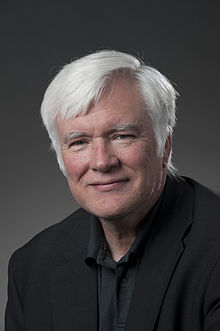Christopher T. Hill | |
|---|---|
 | |
| Born | June 19, 1951 |
| Nationality | American |
| Alma mater | M.I.T. Caltech |
| Known for | Infrared fixed point of the top quark; Topcolor; Top quark condensate; Dimensional deconstruction; Chiral symmetry breaking in Heavy-Light Mesons; Theory of UHE Cosmic Rays; Soft Nambu-Goldstone Boson model of Dark Matter. |
| Scientific career | |
| Institutions | Fermilab |
| Doctoral advisor | Murray Gell-Mann |
Christopher T. Hill (born June 19, 1951) is an American theoretical physicist at the Fermi National Accelerator Laboratory who did undergraduate work in physics at M.I.T. (B.S., M.S., 1972), and graduate work at Caltech (Ph.D., 1977, Murray Gell-Mann[1]). Hill's Ph.D. thesis, "Higgs Scalars and the Nonleptonic Weak Interactions" (1977) contains one of the first detailed discussions of the two-Higgs-doublet model and its impact upon weak interactions.[2]
Hill is an originator, with William A. Bardeen and Manfred Lindner, of the idea that the Higgs boson is composed of top and anti-top quarks. This emerges from the concept of the top quark infrared fixed point,[3] which predicted (1981) that the top quark would be very heavy, contrary to most popular ideas at the time. The fixed point prediction lies within 20% of the observed top quark mass (1995). This implies that the top quarks may be strongly coupled at very short distances and could form a composite Higgs boson, which led to top quark condensates,[4] topcolor,[5][6] and also dimensional deconstruction, which is a renormalizable, lattice description of extra dimensions of space.[7] Several new heavy Higgs bosons, such as the b-quark Higgs bound state, may be accessible to the LHC.[8] [9] [10]
Hill coauthored (with Elizabeth H. Simmons) a comprehensive review of strong dynamical theories and electroweak symmetry breaking that has shaped many of the experimental searches for new physics at the Tevatron and LHC.[11]
Heavy-light mesons contain a heavy quark and a light anti-quark, and provide a window on the chiral symmetry dynamics of a single light quark. Hill and Bardeen showed that the (spin)parity ground states are split from the parity partners by a universal mass gap of about due to the light quark chiral symmetry breaking.[12] This correctly predicted an abnormally long-lived resonance, the and numerous decay modes which have been confirmed by experiment.[13] Similar phenomena should be seen in the mesons and (heavy-heavy-light baryons).
Hill has done extensive work on topological interactions and, with collaborators, obtained the full Wess-Zumino-Witten term for the Standard Model, including pseudoscalars, spin-1 vector mesons, and the and . This revealed new anomalous interactions such as where is a heavy nucleus.[14]
He is also an originator of cosmological models of dark energy and dark matter based upon ultra-low mass bosons associated with neutrino masses and was first to propose that the cosmological constant is connected to the neutrino mass, as .[15] [16] and has developed modern theories of the origin of ultra-high-energy nucleons and neutrinos from grand unification relics, such as cosmic strings.[17] [18][19][20] He has also shown that a cosmic axion field will induce an oscillating electric dipole moment for any magnet.[21][22] With Graham Ross he has focused more recently on spontaneously broken scale symmetry (or Weyl symmetry), where the scale of gravity (Planck mass) and the inflationary phase of the ultra-early universe are generated together as part of a unified phenomenon dubbed "inertial symmetry breaking."[23] [24][25]
Hill is Distinguished Scientist Emeritus at Fermilab; Head of the Fermilab Theoretical Physics Department (2005 - 2012); CERN Scientific Associate, Geneva, Switzerland (1987-1988); Fellow of the American Physical Society (elected, 1989);[26] Robert A. Millikan Fellow, Caltech (1972-73); Arthur H. Compton Lecturer, University of Chicago, Spring (1979); Visiting Scholar, Oxford University (1980); Professor of Physics (adjunct), University of Chicago, (1996–2000); Gambrinus Fellow, University of Dortmund, (2005); van Winter Lecturer, University of Kentucky (2009); Visiting Professor, Institut de Fisica Corpuscular, Valencia, Spain (2019).
Hill has authored three popular books with Nobel laureate Leon Lederman about physics and cosmology, and the commissioning of the Large Hadron Collider.










